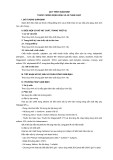
66 Tạp chí Y Dược học - Trường Đại học Y Dược Huế - Số 12
HỘI CHỨNG TRÀN DỊCH MÀNG
NGOÀI TIM SAU MỞ MÀNG TIM
Lê Quang Thứu
Bộ môn Ngoại, Trường Đại học Y Dược Huế
Tóm tắt
Mục tiêu: Ngày nay mặc dù đã có nhiều tiến bộ trong phu thut tim hở cũng như trong hồi sức
sau mổ, tràn dịch màng ngoài tim vn là một biến chứng hay gặp trong phu thut tim hở. Việc sử
dng lâu ngày các thuốc chống đông và tính chất của phu thut ngày càng phức tạp nên tỷ lệ tràn
dịch màng ngoài tim sau phu thut tim hở cũng tăng lên. Đối tượng và phương pháp nghiên cứu:
Phương pháp mô tả cắt ngang và tiến cứu. Tất cả bệnh nhân vào viện do tràn dịch màng ngoài tim
sau phu thut tim hở từ 1/2010 đến 9/2012. Nghiên cứu đặc điểm lâm sàng, cn lâm sàng, đánh giá
kết quả điều trị tràn dịch màng ngoài tim sau phu thut tim hở. Kết quả: Các biểu hiện lâm sàng
của hội chứng tràn dịch màng ngoài tim sau mở màng tim là không đặc hiệu. Chỉ có một số ít bệnh
nhân có dấu hiệu lâm sàng chèn ép tim cấp. Siêu âm tim là phương tiện chẩn đoán chính xác tràn
dịch màng ngoài tim sau phu thut tim hở. Phương pháp điều trị chủ yếu vn là dn lưu khoang
màng ngoài tim bằng mở cửa sổ màng tim chiếm 100% trường hợp. Kết luận: Tràn dịch màng
ngoài tim là một trong những biến chứng hay gặp sau phu thut tim hở đặc biệt là ở các bệnh nhân
thay van. Các biểu hiện lâm sàng trong tràn dịch màng ngoài tim là không đặc hiệu nên phương thức
chẩn đoán chính là siêu âm tim kiểm tra.
Abstract:
POSTOPERATIVE PERICARDIAL EFFUSION SYNDROME
Le Quang Thuu
Dept. of Surgery Medical, Hue University of Medicine and Pharmacy
Objective: Today, despite many recent improvements in intraoperative management and
postoperative care, late pericardial effusions remain an important cause of morbidity after cardiac
surgery. Because of widespread use of chronic anticoagulation and increased complexity of
operations, the incidence of effusion may be higher. Thus we need to update the information
on the symptoms, risk factors, diagnostic methods and treatment of Postoperative pericardial
effusion syndrome. Patients and methods: A cross-sectional and prospective study of all
patients admitted to hospital because of pericardial effusion after open heart surgery from
1/2010 to 9/2012. Study the clinical characteristics, paraclinicals, evaluate the results of
treatment of pericardial effusion after open heart surgery. Results: Symptoms of pericardial
effusion are nonspecific. Some patients with pericardial effusion report minimal problems. In
the present study, few patients have the classic presentation of tamponade. Echocardiography
is the diagnostic accuracy pericardial effusion after open heart surgery. This treatment mainly
is pericardial drainage with 100%. Conclusion: Pericardial effusion is a common complication
after open-heart surgery, symptoms of pericardial effusion are nonspecific to diagnostic method is
echocardiographic surveillance.patients can be treated with internal medicine if has no tamponade
and less fliuds. Pericardial drainage is absolute only in patients with pericardial effusion with signs
of cardiac tamponade or pericardial many of effusion.
DOI : 10.34071 / jmp.2012.6.8








































